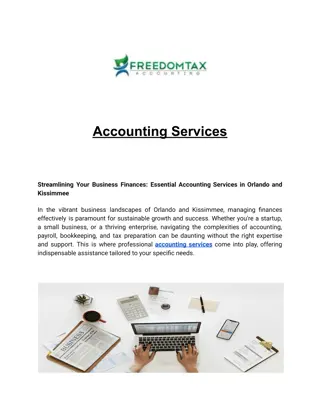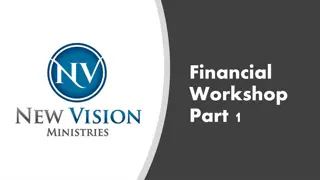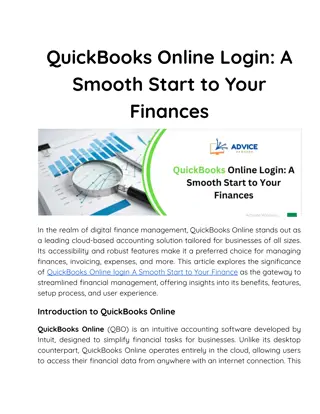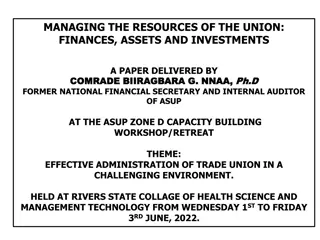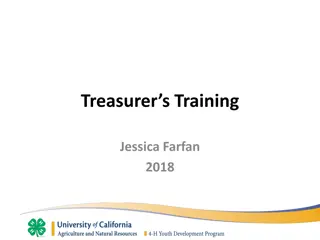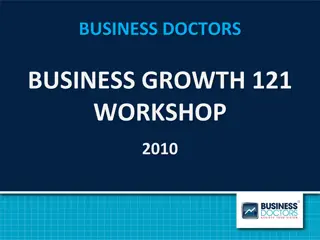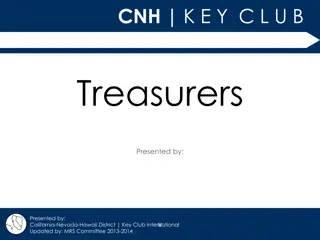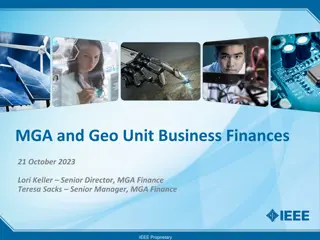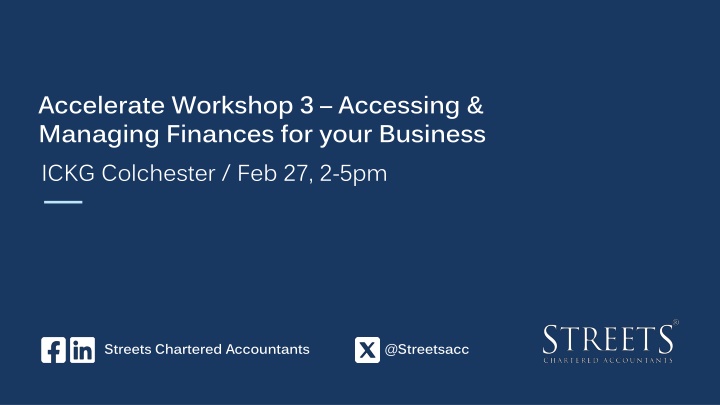
Accessing & Managing Finances for Your Business Workshop
Join the Accelerate Workshop 3 on Feb. 27, 2-5pm at Streets Chartered Accountants in Colchester. Learn how to improve business performance through effective financial management strategies and technology. Dean Wright, a Chartered Certified Accountant, will be sharing insights on accountancy, taxation, and software needs for businesses and individuals. Streets is a reputed firm offering a range of services including audit, tax advisory, corporate finance, and more. Explore the world of financial consulting with experts guiding you towards financial success.
Download Presentation

Please find below an Image/Link to download the presentation.
The content on the website is provided AS IS for your information and personal use only. It may not be sold, licensed, or shared on other websites without obtaining consent from the author. If you encounter any issues during the download, it is possible that the publisher has removed the file from their server.
You are allowed to download the files provided on this website for personal or commercial use, subject to the condition that they are used lawfully. All files are the property of their respective owners.
The content on the website is provided AS IS for your information and personal use only. It may not be sold, licensed, or shared on other websites without obtaining consent from the author.
E N D
Presentation Transcript
Accelerate Workshop 3 Accessing & Managing Finances for your Business ICKG Colchester / Feb 27, 2-5pm @Streetsacc Streets Chartered Accountants
About me Dean Wright I am a Chartered Certified Accountant, advising and assisting both businesses and individuals on their accountancy, taxation and software needs. Director, FCCA Based in the Colchester office but have clients across South East, with specific responsibility for servicing and developing client businesses around Essex, Hertfordshire and Bedfordshire. T: 01206 762200 E: dean.wright@streets.uk I am particularly interested in the use of technology and digital practices to ensure that timely and meaningful management information is used to good effect in analysing trends and forecasting future behavior to improve business performance. This is a particular focus when providing commercial business and tax advice to entrepreneurial and SME clients. https://app.queue.codes/dean_wright I enjoy working with start-ups, scale-ups and owner managed businesses. I also actively engaged in supporting new and growing enterprises located in the various innovation centres located across the region. Such work includes Research and Development (R&D) tax credits, Innovate UK and crowd-funding, film and gaming credits. As an accounting software specialist, I am a Xero Certified Advisor and a QuickBooks online accredited advisor.
Introduction to Streets Streets is a well-established and widely respected mid-tier, top 40 UK firm of Chartered Accountants, advising a diverse portfolio of entrepreneurial growth companies, high net worth individuals and third sector not for profit organisations. We are a full-service firm offering audit and assurance services, indirect and direct tax advisory and compliance services, as well as corporate finance and employment tax advisory services to our clients. As a truly multi-disciplinary practice we also offer commercial legal advice and services, along with personal financial planning. We look after the international compliance and advisory needs of clients trading or investing overseas and provide a seamless cross border service through our own international association of specialist advisory firms SBC Global Alliance. The practice was founded in 1907 and today has annualised fee income of 26 million+, 57 partners. directors and over 230 staff.
Firm Overview Streets Whittles Chartered Accountants Streets Whittles provides accountancy and advisory services for clients in our offices in Essex. Streets Whittles is registered and regulated by the Institute of Chartered Accountants in England & Wales. This is the firm s dedicated audit arm and will be the official engagement firm for the provision of services as outlined in the scope of work. Streets Audit LLP is registered by the Institute of Chartered Accountants in England and Wales (ICAEW) to carry out audit work. Streets Audit LLP Streets Tax LLP The firm s dedicated tax practice brings together a group of tax professionals whose aim is to ensure personal and business clients minimise their tax payments, both now and in the future. Streets Financial Consulting Plc The firm s independent financial planning arm provides a holistic approach to the management of client s personal financial affairs to help achieve their individual needs and aspirations. Streets Financial Consulting plc is authorised and regulated by the Financial Conduct Authority. The firm s specialist team of accountants and tax and financial advisers who are well versed in, and have a successful track record for, completing transactions and deals for our clients. The core of our work relates to the buying, selling and restructuring of businesses and in raising finance where necessary. Streets Corporate Finance SBC Global Alliance SBC Global Alliance is the firms own association of international independent firms providing audit, tax, accounting, assurance and business advisory services around the world.
Todays plan Financial Forecasting Managing Your Finances Financial Documents Financial Documents Breakeven Point Breakeven Point Key Accounting Terms Key Accounting Terms Business Run Rates Business Run Rates Forecasting Tips and Tricks Forecasting Tips and Tricks Tips and tricks Tips and tricks Produce Your Own Forecast Produce Your Own Forecast
Financial Documents (as part of your business plan)
What financial documents are required for an investor or lender? This will detail your income and expense projections over a timeline. Showing gross profit, net profit, units and currency. Profit and loss This will detail all your business assets and liabilities. This can be equipment, property, money in the bank, money owed from customers, money owed to suppliers, taxes, wages, loans and debts. Balance Sheet This will show all the money coming in and out of the business over a timeline through operating, investing and finance activities. It's important, as cash is king in a business. It should allow for timing of cash in and out based on various conditions and expectations known at the time of preparation. Cashflow It s important to include a description and breakdown of key workings and assumptions you have made, so the reader can understand and make their own judgement on any assumptions you have made. Assumptions
Profit and loss What do you expect to see? Sales Showing currency, amount, a breakdown how its arrived at, seasonal trends. Direct Costs Showing material, labour, delivery costs, anything directly related to sale This is the margin made on sale vs direct cost. This is before overheads but should allow for enough meat on the bone . Gross Profit Any other cost to the business, salaries, rent, light and heat, advertising, insurance, professional fees, finance costs. Overheads What did the business make from its trading activities after all income and costs accounted for. Before tax and dividends. Net Profit
Balance sheet What do you expect to see? Fixed and Intangible Assets This will show equipment and property, but also potentially intangible like goodwill, licenses, patents etc Current Assets This will show money owed from customers, money in the bank, and perhaps prepaid costs. Current Liabilities This will show money owed to suppliers, taxes such as PAYE, VAT, Corporation tax, loans and debts. This will typically show funds owed to and from third parties that are considered more than 1 year. Example investor or loans. Long term Capital and Reserves This will show share capital invested in the company and typically retained earnings from trading activities.
Cashflow What do you expect to see? Income This will show your (sales) income collection, showing any terms and collection of VAT perhaps. This will show any commitments to borrowings, overheads and cost of sales payable, again showing terms and VAT effect. Liabilities Funds to shareholders This should show expectation of dividends to shareholders. This will need to account for taxes such as PAYE, VAT and Corporation tax. Different dates of payment for each. Taxes Investment and financing This would show repayments on investments and finance but also perhaps inwards investment.
Key Accounting Terms More can be found on handout
Common accounting terms This ratio measures the profitability of your core business activities by subtracting the cost of goods sold (COGS) from total revenue and expressing it as a percentage of revenue. It helps assess your ability to generate profit from your products or services. Gross Profit Margin Net Profit Margin This KPI calculates the percentage of profit remaining after all expenses, including operating expenses and taxes, are deducted from revenue. It provides a clear view of overall profitability. Burn rate measures how quickly your business is using up its available cash. It's crucial to understand when you're likely to run out of cash if your current spending patterns continue Burn Rate This ratio measures your ability to cover short-term obligations with current assets. A current ratio above 1 indicates good short-term liquidity Current Ratio Return on Investment (ROI) ROI assesses the profitability of investments or projects. It's crucial for evaluating the effectiveness of capital expenditures or marketing campaigns. Earnings Before Interest, Taxes, Depreciation, and Amortization (EBITDA):** EBITDA is a measure of operating performance and profitability, excluding non-operating expenses and non-cash items. EBITDA
Forecasting Tips and Tricks When preparing financial forecasts to seek or obtain financing, entrepreneurs and business owners often make several common mistakes. These errors can undermine their credibility with lenders or investors and reduce the chances of securing the needed funds. Here are some of the most common mistakes to avoid:
Tips and Tricks Overly Optimistic Revenue Projections Problem: One of the most common mistakes is projecting unrealistically high sales or revenue figures. Entrepreneurs may be overly optimistic about their growth potential, leading to inflated forecasts. Solution: Avoid making projections without a solid basis in market research or historical data. Problem: Underestimating operational costs, including operating expenses, cost of goods sold, and unexpected expenses, can result in cash flow problems. Solution: Carefully analyze all potential costs and consider contingencies. Underestimating Expenses Ignoring Seasonality and Cyclicality Problem: Failing to account for seasonality or cyclicality in your business can lead to inaccuracies in your forecasts. Solution: Consider how external factors and industry trends may impact your financial performance throughout the year. Problem: Some entrepreneurs provide vague or incomplete financial forecasts, omitting crucial details that would help lenders or investors understand their assumptions. Solution: Ensure your forecasts are detailed and transparent, including assumptions, methodologies, and data sources. Lack of Detail Problem: Inconsistencies between different parts of your financial forecast, such as a mismatch between revenue growth and expense growth, can raise doubts about the accuracy of your projections. Solution: Ensure that all elements of your forecast are aligned and consistent. Inconsistent Projections
Tips and Tricks Problem: Failing to acknowledge potential risks and uncertainties in your business plan can erode investor or lender confidence. Solution: Discuss how you plan to mitigate risks and provide sensitivity analysis to show how changes in assumptions could impact your financials. Not Adequately Addressing Risk Problem: Overlooking the working capital requirements necessary to support growth can lead to cash flow shortages. Solution: Include working capital calculations in your forecasts to ensure you have the necessary funds to operate and expand. Neglecting Working Capital Needs Problem: While financial software can be a valuable tool, relying solely on it without human judgment can lead to errors. Solution: Use financial software as a tool but also engage in a thoughtful, manual review of your forecasts. Relying Solely on Financial Software Problem: Entrepreneurs sometimes resist feedback from financial professionals, investors, or lenders, leading to missed opportunities for improvement. Solution: Be open to constructive criticism and make necessary adjustments to your forecasts based on expert advice. Ignoring Feedback
Tips and Tricks Not Problem: Lenders and investors want to see that you understand your financials. Failing to demonstrate financial literacy can undermine confidence. Solution: Invest time in learning about financial management or consider working with financial experts. Demonstrating Financial Expertise Problem: When taking on debt, entrepreneurs may not account for the interest and principal payments in their forecasts. Solution: Be sure to include debt service obligations in your financial projections to understand the full financial impact. Overlooking Debt Service Problem: Failing to effectively communicate your financial forecasts, assumptions, and growth strategies during presentations or meetings can lead to misunderstandings. Solution: Practice clear and concise communication when discussing your financial projections with potential lenders or investors. Inadequate Communication By avoiding these common mistakes and presenting well-researched, realistic financial forecasts, entrepreneurs can enhance their credibility and increase their chances of successfully obtaining financing.
Breakeven Point
Breakeven Point Unit break-even analysis: Unit break-even analysis focuses on determining the number of units a business needs to sell to cover its total costs and reach a break-even point. This analysis takes into account the fixed and variable costs. Break-even units = fixed costs (selling price per unit variable costs per unit) Example: A shed company that wants to introduce a new product to the market could use this method to determine the number of units it needs to sell to cover all its costs and start making a profit. Sales break-even analysis: Sales break-even analysis determines the number of sales required to reach the break-even point. Instead of focusing on the number of units, this analysis looks at the sales volume in terms of monetary value. It takes into account the fixed costs, variable costs, and the unit selling price. Break-even sales = fixed costs (1 variable costs ratio) Example: A retail chain with multiple stores and wants to evaluate the profitability of each location could use this method to determine the minimum sales revenue required to cover all fixed and variable costs for each of its stores. This method would also help the company identify stores that are not meeting their break-even point, and that may require restructuring or closure. It would also allow the chain to compare the performance of its different stores, helping inform their decisions on store expansion or whether to hire more staff. What is breakeven Point and Why is it Important? A break-even point is the point at which a business neither makes a profit nor incurs a loss, and where the total revenue equals total costs. It is also the tipping point from where your business could operate at a loss, or turn a profit. Knowing your break-even point helps you understand the level of sales needed to cover all expenses and reach profitability. It's a critical milestone for startups. Your break-even point helps you determine the minimum sales needed to cover costs and make informed pricing decisions. It will help you plan production levels effectively, and assess the viability of your business model before you approach any investors. To calculate your break-even point, you ll need to consider three main factors: fixed costs, variable costs, and the selling price. The formula for determining the break-even point is relatively straightforward: Break-even point = fixed costs (selling price variable costs per unit) Break-even point: the level of sales at which your total revenue covers all costs, resulting in neither a profit nor a loss. Fixed costs: fixed costs refer to expenses that remain constant, regardless of the level of production or sales. Examples include rent, salaries, insurance, and utilities. Variable costs: variable costs, on the other hand, are directly tied to the level of production or sales. These fluctuate in proportion to the volume of goods or services produced. Examples of variable costs include raw materials, direct labour, and shipping costs. Selling price: the amount you charge customers for your product or service.
Breakeven Point Time break-even analysis: Time break-even analysis allows you to estimate how long it will take to reach the break-even point and recoup your initial company investments. This analysis considers the fixed costs, variable costs, and the expected sales revenue over a specific period. Factors affecting your break-even point There are various factors that can impact your break-even point: Fixed and variable costs: the higher these costs are, the higher they raise the break-even point because more revenue is needed to cover expenses. By analysing the monthly or yearly net cash flow, businesses can determine the time required to recover their initial investment and begin generating profits. Time break-even analysis is particularly useful when evaluating the viability of new ventures or projects with significant upfront costs. Break-even time = fixed costs (sales variable costs per unit) per time period A startup company that has developed a new software application and has started seeking external funding may use this method. Because investors want to understand when the company is projected to achieve profitability, the company can use this method to estimate the time it will take to reach the break-even point. Selling price: a higher selling price lowers the break-even point, while a lower selling price raises it. Market demand: the level of market demand for a product or service can significantly impact the break-even point. Increased demand can lead to a lower break-even point since more units can be sold, spreading the fixed costs over a larger sales volume. This allows the business to achieve profitability quickly. Decreased demand may raise the break-even point as fewer units are sold, resulting in higher costs per unit and a longer time to break even. Competition: competition within the industry also plays a role when determining the break-even point. In a highly competitive market, intense competition can put pressure on pricing strategies, so a careful cost analysis would be necessary to maintain a viable break-even point. This is crucial information for the company to be able to communicate in order for confidence in the company to be secured, and for investment decisions to go ahead.
Breakeven Point How do you use your break-even analysis? Break-even analysis offers valuable insights that can guide your business decisions by helping you to: Set prices: by knowing your break-even point, you can establish pricing strategies that ensure profitability. Conclusion Calculating your breakeven point is a valuable tool in your business plan. It provides information on profitability, strategy, planning and decisions. It gives you the power to make better decisions to achieve the success required. Its important to recognise the limitations, simplifications and assumptions. This can then lead to realistic goals, determine feasibility and allow for adjustments to long term operations. Plan production: understanding your break-even point helps optimise production levels and avoid over/underproduction. Make financial decisions: break-even analysis assists with the assessment of the financial feasibility of new projects, expansions, or cost-cutting measures. What are the limitations of break-even analysis? While break-even analysis is a valuable tool, it has certain limitations: Estimates: your break-even point will always be based on estimates and assumptions about cost behavior, sales volume, and other factors that, ultimately, may not always hold true in the end. While it is still a worthwhile practice, this is something to keep in mind. Static analysis: break-even analysis assumes a constant cost structure, neglecting potential changes over time. Cash flow: it does not consider the timing of cash inflow and outflow, which is vital for managing liquidity.
Business Run Rates
Business Run Rates Burn rate measures how quickly your business is using up its available cash. It's crucial to understand when you're likely to run out of cash if your current spending patterns continue. Gross Burn Rate = Cash/Monthly Operating Expenses Net Burn Rate= Cash/ Monthly Operating Losses High Burn rate = either financial stress or more cash needed from investor before relies revenue/ profitability Reduce = Layoffs or pay cuts, Growth and economies of scale, marketing cheap and clever ways hyperlink, back link Burn Rate Churn rate calculates the percentage of customers who stop using your product or service over a specific period. A high churn rate may indicate issues with customer retention. Why that s important, well growth and revenue. Churn Rate = (total number of customers lost/total number of customers acquired) x 100 Consider Netflix and Broadband provider. Churn Rate This KPI measures the rate at which your company's sales are increasing over a particular period. Consistent growth is often a key goal for startups and scale-ups. Sales Growth Rate = (Sales for the current period Sales for the previous period/ Sales for the previous period) x 100 Consider supermarkets. How to improve: Expansion close to home, promote further products, training, communication. Sales Growth Rate
Final Top Tips and Tricks
Tips and Tricks - Finance Business Bank Account Setup a business bank account, shop around watch fees, keep personal and business separate from one another, keep within means the business can afford, do not draw on loans for personal expenditure BBL. Set aside money for the tax bills VAT, PAYE and Corporation tax. Think about business deposit accounts or pots to save. Tax Bills Think about using online accounting software as soon as possible, Xero, Quickbooks, Sage, Freeagent. Good discipline sales invoicing, receipt capture, bank feed perks! Software Report and Monitor Monthly management accounts prepared, board meeting to discuss, consider contingent fund, track against forecasts/budgets Lack of capital to start requirements? Ease of customer payment stripe, gocardless, Klarna Working capital cycle Inventory, accounts payable, accounts receivable Overspend on team - consider noncash perks or equity BUT on back of milestones or achievements Cashflow
Accelerate Workshop 3 Accessing & Managing Finances for your Business ICKG Colchester / Feb 27, 2-5pm Dean Wright Director, FCCA T: 01206 762200 E: dean.wright@streets.uk https://app.queue.codes/dean_wright @Streetsacc Streets Chartered Accountants www.streets.uk www.streetswhittles.co.uk


